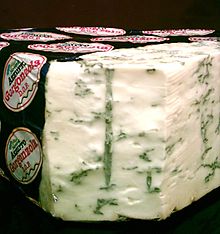Gorgonzola (cheese)
| Gorgonzola | |
|---|---|
 
|
|
| Country of origin | Italy |
| Region, town | Gorgonzola |
| Source of milk | Cow |
| Pasteurized | Yes |
| Texture | Soft and crumbly |
| Fat content | 25-35% |
| Aging time | 3–4 months |
| Certification | Italy: DOC from 1955; EU: PDO from 1996 |
Gorgonzola (/ɡɔːrɡənˈzoʊlə/; Italian pronunciation: [ɡorɡonˈdzɔːla]) is a veined Italian blue cheese, made from unskimmed cow's milk. It can be buttery or firm, crumbly and quite salty, with a "bite" from its blue veining.
Gorgonzola has been produced for centuries in Gorgonzola, Milan, acquiring its greenish-blue marbling in the eleventh century. However, the town's claim of geographical origin is disputed by other localities.
Today, it is mainly produced in the northern Italian regions of Piedmont and Lombardy. Whole cow's milk is used, to which starter bacteria are added, along with spores of the mold Penicillium glaucum. Penicillium roqueforti, used in Roquefort cheese, may also be used. The whey is then removed during curdling, and the result aged at low temperatures.
During the aging process metal rods are quickly inserted and removed, creating air channels that allow the mold spores to grow into hyphae and cause the cheese's characteristic veining. Gorgonzola is typically aged for three to four months. The length of the aging process determines the consistency of the cheese, which gets firmer as it ripens. There are two varieties of Gorgonzola, which differ mainly in their age: Gorgonzola Dolce (also called Sweet Gorgonzola) and Gorgonzola Piccante (also called Gorgonzola Naturale, Gorgonzola Montagna, or Mountain Gorgonzola).
...
Wikipedia
